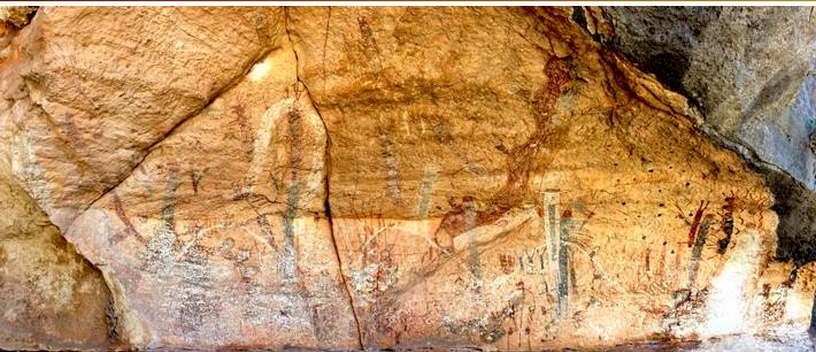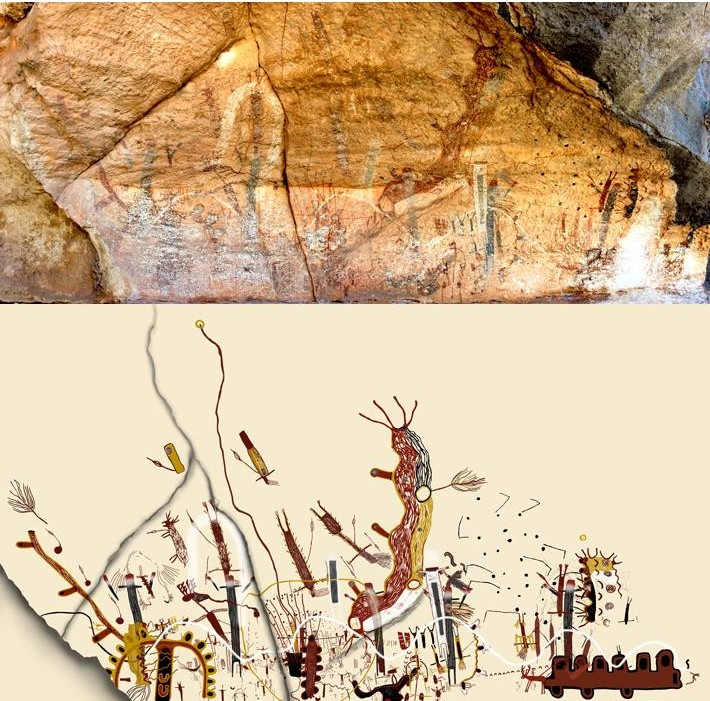
Down in southwest Texas, a unique-in-the-world style of ancient rock art is bringing to life a culture of hunter-gatherers with a penchant for incredible art, spiritual journeys, and wild imaginations.
Archeologists studying the site for more than 30 years have discovered much about this strange culture dating from 2,500 BC to 600 AD—and digital renderings of their rock art reveal their Animistic belief systems as never before.
Down where the Pecos River flows into the Rio Grande, an archeological site called the White Shaman rock shelter includes a 26-foot-long rock wall facing west. It’s long been known that this wall has been the site of pictographic art, but it wasn’t until Carolyn Boyd arrived in 1989 that the true extent of the White Shaman wall would be revealed.
At that time, Boyd was, of all things, a professional muralist who painted for commission. Once thought to be unconnected scribbles made by hunter-gatherers in the Pecos River area over long periods of time, Boyd needed only a short look to figure out all the drawings were connected.
“I could tell at once that it had been planned and conceived as a single composition,” Boyd told Archaeology Magazine, reporting on her discoveries at the site. “And because I was a muralist, I knew the skill it took to produce something like this, and to do it so beautifully. I was awed.”
For one thing, the height of the rock wall would require scaffolding to reach the upper sections of the drawings. Secondly, it would have required time to gather all the minerals, plants, and animal fats to create the pigments. For these reasons she was sure all the images were linked.

A mysterious culture
White Shaman rock shelter is only one site in the area. Rattlesnake Canyon has a rock wall 100 feet long with depictions in the same style, now called the Pecos River Style, and other archeologists working in the area have documented 300 such murals containing this kind of art, which Boyd and her teams at the Shumla Archeological Research and Education Center describe as the “oldest books in North America.”
Boyd noticed that three vertical levels covered the White Shaman wall, which she interpreted as the underworld, middle-world, and upper world, a foundational belief across many Mesoamerican cultures. She also noticed that the deer had black-colored antlers, a motif found in the art of the Huichol, who still live in the mountains of western Mexico today.
A series of clues were connected. Studying the Huichol, Boyd learned that their shamans go on a 600-mile pilgrimage to gather the hallucinogenic cacti peyote, and that they do this by following deer, believed to be an animal-manifestation of the plant, with a bow and arrow. At the end of the pilgrimage, the shaman shoot the cactus with their bow, metaphorically sacrificing the deer and the plant, before gathering the peyote “buttons.”
Black-antlered deer depicted with arrows coming out of them surrounded by small button-shaped dots have been recorded on White Shaman’s walls, nearby to which arrowheads and peyote residue have been recovered from digs.
Boyd later concluded that not only was the entire painting a visual guide on how to carry out the peyote pilgrimage, but that it displays the creation myth of several ancient cultures including the Pecos River people, the Huichol, and the nearby Nahua, simultaneously. (See the video below.)
The Master Narrative
In painting the depictions of the the creation of the sun and the dawn of time, through the creation of mankind and other events on the wall at White Shaman, Boyd noted that all the pigments were laid down in precise strata; in the sense that all the black pigment was applied first across the whole mural.
Black was the primordial color of shadow and femininity. Next, all the red pigments were put down, symbolizing not only masculinity, but also the color of the sky at dawn. Then came all the yellows—the color of the sun, and then white, the shadow-less world and perhaps also the world of gods.

The Dawn Arch, a fundamental symbol of other Mesoamerican beliefs, is seen on the left, after which the peyote pilgrims from the ritual story become the five godlike ancestors in the Huichol and Nahua traditions—walking towards the arch with torches to stoke the flames of the first sunrise.
SIMILAR: Incredible Discovery Beneath the Southern Amazon Reveals Urban-Agrarian Society Never Seen Before
The largest pictograph is the Mother Goddess of the Huichol belief system: a half-serpent half-catfish being rising up to the meet the sun at noon.
Her colleagues consider her work ground-breaking.
“This style is the oldest large group of pictographs in the New World and it’s been overlooked by Mesoamericanists,” Texas Tech art historian Carolyn Tate, who is an authority on Olmec art, told Archaeology Magazine. She’s making us pay attention to the idea that this could be the northern frontier of Mesoamerica.”
“Some of the motifs she’s identified—such as the crenellated arch—these are visual patterns you see in Nahua manuscripts.”
Protecting them for all time
In January, Sect. of the Interior Deb Haaland designated the Lower Pecos Canyonlands a National Historic Site, to fall under the protection of the National Parks Service as recognition for the incredible value of the rock art at places like White Shaman.
Work on the sites continued. 6-months later, Boyd outlined the presence of the Pecos River style’s “Speech-Breath” motif in a scientific paper.
“Artists used this graphic device to denote speech, breath, and the soul. They communicated meaning through the image-making process, alternating brushstroke direction to indicate inhalation versus exhalation or using different paint application techniques to reflect measured versus forceful speech,” she explains in the journal Latin American Antiquity.
CONTINUE READING: Amaranth is a Health Trend 8,000 Years Old That ‘Could Feed the World’
“The choices made by artists in the production of the imagery reflect their cosmology and the framework of ideas and beliefs through which they interpreted and interacted with the world.”
Boyd founded the aforementioned Shumla Center in Comstock TX, who are trying to protect and make this information known to the world. They run guided tours through the canyon lands, and have used digital renderings to database, and to bring the rock art to life in a way that hasn’t been seen since the age they were painted.
WATCH their own creation story below…
BE a SHAMAN for Your Friends By Sharing The Magic On Social Media…



















